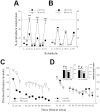High impulsivity predicts the switch to compulsive cocaine-taking
- PMID: 18535246
- PMCID: PMC2478705
- DOI: 10.1126/science.1158136
High impulsivity predicts the switch to compulsive cocaine-taking
Abstract
Both impulsivity and novelty-seeking have been suggested to be behavioral markers of the propensity to take addictive drugs. However, their relevance for the vulnerability to compulsively seek and take drugs, which is a hallmark feature of addiction, is unknown. We report here that, whereas high reactivity to novelty predicts the propensity to initiate cocaine self-administration, high impulsivity predicts the development of addiction-like behavior in rats, including persistent or compulsive drug-taking in the face of aversive outcomes. This study shows experimental evidence that a shift from impulsivity to compulsivity occurs during the development of addictive behavior, which provides insights into the genesis and neural mechanisms of drug addiction.
Figures




References
-
- Everitt BJ, Robbins TW. Nat Neurosci. 2005;8:1481. - PubMed
-
- Jentsch JD, Taylor JR. Psychopharmacology (Berl) 1999;146:373. - PubMed
-
- Koob GF, Le Moal M. Neuropsychopharmacology. 2001;24:97. - PubMed
-
- Kreek MJ, Nielsen DA, Butelman ER, LaForge KS. Nat Neurosci. 2005;8:1450. - PubMed
-
- Chakroun N, Doron J, Swendsen J. Encephale. 2004;30:564. - PubMed
Publication types
MeSH terms
Substances
Grants and funding
LinkOut - more resources
Full Text Sources
Other Literature Sources
Medical

